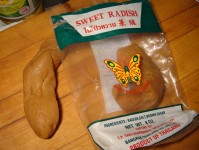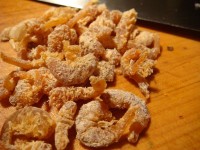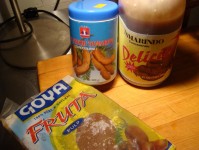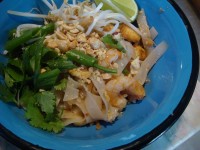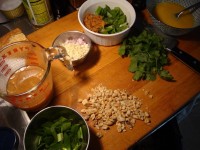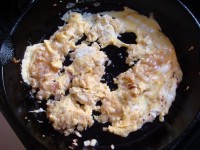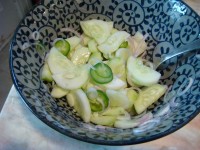Podcast: Play in new window | Download
This week, by special request from a fellow New Mexican, I cook up a batch of the distinctive red chile sauce used all over everything in New Mexico.
New Mexico Red Chile Sauce
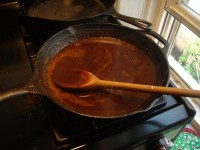 I usually eat this on scrambled or fried eggs, topped with some grated cheese and briefly melted under the broiler. You can of course use it for a batch of enchiladas (you might want to double the recipe), but I find I rarely get there before I eat it all up. It’s also good dropped in posole (hominy stew). It lasts for about a month in the refrigerator, in a tightly sealed jar, and it tastes better if you let it sit overnight and reheat.
I usually eat this on scrambled or fried eggs, topped with some grated cheese and briefly melted under the broiler. You can of course use it for a batch of enchiladas (you might want to double the recipe), but I find I rarely get there before I eat it all up. It’s also good dropped in posole (hominy stew). It lasts for about a month in the refrigerator, in a tightly sealed jar, and it tastes better if you let it sit overnight and reheat.
As I say in the podcast, purists often don’t use any spices at all. If you do use them, go light–too much cumin or oregano can make the whole thing taste kind of muddy and cheap.
Makes about 2 1/4 cups
1/2 cup ground New Mexico red chile
scant 2 tbsp flour (about 2 heaping teaspoons)
1/4 tsp ground cumin (optional)
1/2 tsp ground coriander (optional)
2 tbsp lard or vegetable oil
2 cloves garlic
2 cups water or chicken stock
Pinch salt
Pinch dried oregano (optional)
Turn on your kitchen fan or open a window–the oils in the chile can make you cough.
Heat a heavy skillet over medium heat. Add the chile, flour, and, if using, cumin and coriander, and quickly stir to toast the spices, just until fragrant and the chile darkens slightly. Take the skillet off the heat if you’re worried the chile has gone too far, and continue to stir the dry mix until it cools a little.
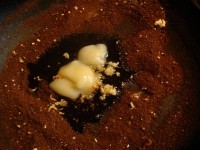 Scrape the dry mix to the sides of the pan to leave an empty spot in the center. Squeeze the two garlic cloves through a press (or mince the garlic very finely beforehand) into the center of the pan, then add the vegetable oil or lard. Stir and fry the garlic until fragrant, then incorporate the dry spices into the oil to make a very thick, dry paste. Fry this a little bit more–maybe just 10 seconds or so, max.
Scrape the dry mix to the sides of the pan to leave an empty spot in the center. Squeeze the two garlic cloves through a press (or mince the garlic very finely beforehand) into the center of the pan, then add the vegetable oil or lard. Stir and fry the garlic until fragrant, then incorporate the dry spices into the oil to make a very thick, dry paste. Fry this a little bit more–maybe just 10 seconds or so, max.
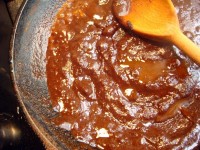 Slowly add the water or chicken stock, stirring constantly and working out any lumps you see. The sauce will thicken almost instantly (as in the photo), but by the time you’ve added the full 2 cups of water, it will be quite thin again–this is fine. Add a pinch of salt, and some oregano if you like.
Slowly add the water or chicken stock, stirring constantly and working out any lumps you see. The sauce will thicken almost instantly (as in the photo), but by the time you’ve added the full 2 cups of water, it will be quite thin again–this is fine. Add a pinch of salt, and some oregano if you like.
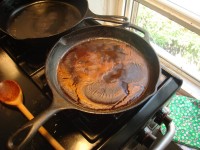 Bring the sauce up to a boil, then immediately turn down to the lowest heat, so that it is just simmering. Let simmer for about 20 minutes or so, until it’s a bit thicker. Stir it occasionally to work in the skin that forms on the top (as in the photo). If it gets very thick, you can always thin it with a bit more water.
Bring the sauce up to a boil, then immediately turn down to the lowest heat, so that it is just simmering. Let simmer for about 20 minutes or so, until it’s a bit thicker. Stir it occasionally to work in the skin that forms on the top (as in the photo). If it gets very thick, you can always thin it with a bit more water.
Store in a jar in the refrigerator. When reheating, you’ll probably need to add a bit of water to thin the sauce out again.
*Lard: Use good freshly rendered stuff (ask for manteca at your Mexican grocery), not the hydrogenated Armour blocks. If you can’t get the good stuff, use vegetable oil.
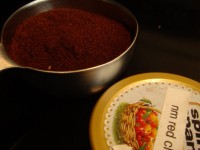 *Chile: Purists usually start not with ground chile, but with whole New Mexican chile pods. And these might also be easier to find outside of New Mexico than the ground chile. Look in your Mexican grocery–they’re often sold alongside all the other varieties (ancho, mulato, etc.) and labeled “New Mexican.” If you’re starting with whole pods, pull of the stems, then crack them open and pull out all or most of the seeds, depending on how much heat you want. (Oh yeah–and one New Mexican cookbook I have advises you to wipe the dust off the chiles first–presumably if they’ve been hanging around on a ristra.) Lay the chile pods out on a cookie sheet and toast them in a 400-degree oven for about five minutes, until they darken and dry out a little bit. Then let them cool, and whiz them up in a spice grinder or a blender. (The cooling is important–hot chiles will release tons of oils into the air, which are painful to breathe.) Then proceed with this recipe, skipping the bit about toasting everything in a dry pan.
*Chile: Purists usually start not with ground chile, but with whole New Mexican chile pods. And these might also be easier to find outside of New Mexico than the ground chile. Look in your Mexican grocery–they’re often sold alongside all the other varieties (ancho, mulato, etc.) and labeled “New Mexican.” If you’re starting with whole pods, pull of the stems, then crack them open and pull out all or most of the seeds, depending on how much heat you want. (Oh yeah–and one New Mexican cookbook I have advises you to wipe the dust off the chiles first–presumably if they’ve been hanging around on a ristra.) Lay the chile pods out on a cookie sheet and toast them in a 400-degree oven for about five minutes, until they darken and dry out a little bit. Then let them cool, and whiz them up in a spice grinder or a blender. (The cooling is important–hot chiles will release tons of oils into the air, which are painful to breathe.) Then proceed with this recipe, skipping the bit about toasting everything in a dry pan.
*Shameless self-promotion: I happen to write two guidebooks to New Mexico for the Moon Handbooks series. If you’re planning a trip to the state (and you should, to get more chile!), check them out here and here.

 New Mexico Red Chile Sauce
New Mexico Red Chile Sauce
